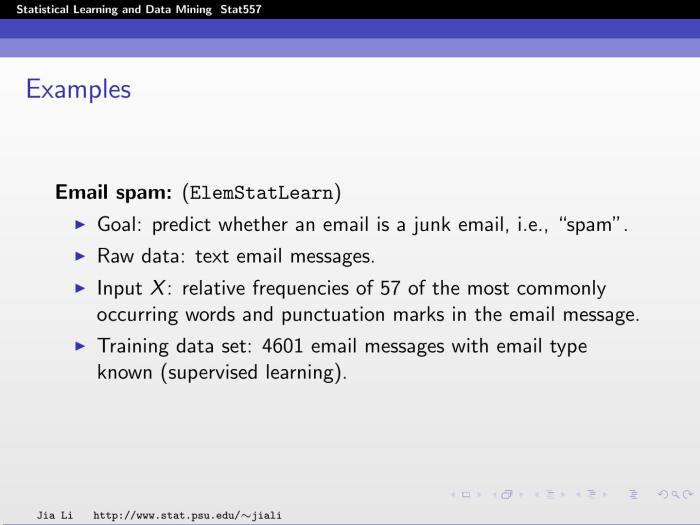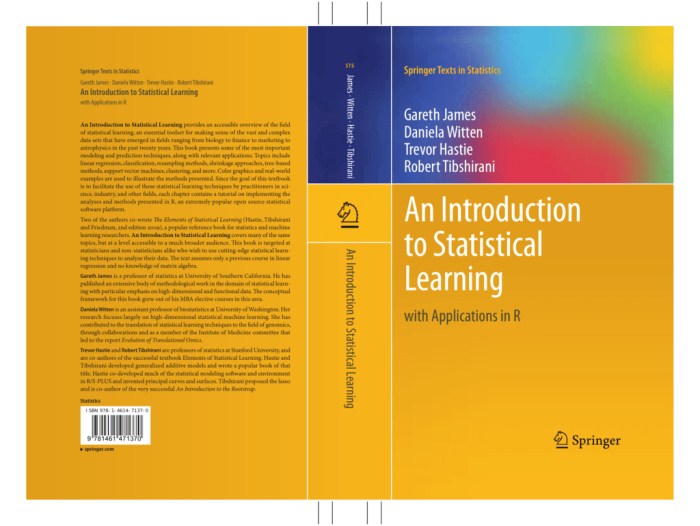An introduction to statistical learning solutions – Embark on an illuminating journey into the realm of statistical learning solutions, where data transforms into actionable insights. This comprehensive guide unravels the fundamentals of statistical learning, empowering you to harness the power of data for informed decision-making.
Statistical learning encompasses a diverse array of techniques, from supervised learning algorithms like regression and classification to unsupervised learning methods such as clustering and dimensionality reduction. By delving into real-world applications, we unveil the practical significance of statistical learning in fields ranging from healthcare to finance.
Introduction to Statistical Learning

Statistical learning is a powerful tool for understanding and predicting the world around us. It allows us to learn from data, even when the data is complex and noisy. Statistical learning has applications in a wide variety of fields, including finance, healthcare, marketing, and manufacturing.
Benefits of Statistical Learning Techniques
- Can identify patterns and relationships in data that would be difficult or impossible to find manually.
- Can make predictions about future events, even when the future is uncertain.
- Can help us to understand the world around us and make better decisions.
Limitations of Statistical Learning Techniques, An introduction to statistical learning solutions
- Can be computationally expensive, especially for large datasets.
- Can be difficult to interpret, especially for complex models.
- Can be biased, if the data used to train the model is not representative of the population of interest.
- Regression algorithms predict continuous values, such as the price of a house or the temperature tomorrow.
- Classification algorithms predict discrete values, such as whether a patient has a disease or not.
- Linear regression is a simple regression algorithm that can be used to predict continuous values.
- Logistic regression is a classification algorithm that can be used to predict discrete values.
- Support vector machines are a powerful classification algorithm that can be used to solve a wide variety of problems.
- Collect a dataset of labeled data.
- Choose a supervised learning algorithm.
- Train the algorithm on the dataset.
- Evaluate the performance of the algorithm on a held-out dataset.
- Clustering algorithms group similar data points together.
- Dimensionality reduction algorithms reduce the number of features in a dataset.
- K-means clustering is a simple clustering algorithm that can be used to group similar data points together.
- Principal component analysis is a dimensionality reduction algorithm that can be used to reduce the number of features in a dataset.
- Collect a dataset of unlabeled data.
- Choose an unsupervised learning algorithm.
- Train the algorithm on the dataset.
- Evaluate the performance of the algorithm on a held-out dataset.
- Cross-validation is a technique for evaluating the performance of a statistical learning model on a held-out dataset.
- The Akaike information criterion (AIC) is a statistical measure that can be used to compare the performance of different statistical learning models.
- The Bayesian information criterion (BIC) is a statistical measure that can be used to compare the performance of different statistical learning models.
Supervised Learning

Types of Supervised Learning Algorithms
Examples of Supervised Learning Algorithms
Process of Training and Evaluating Supervised Learning Models
The process of training and evaluating supervised learning models involves the following steps:
Unsupervised Learning

Types of Unsupervised Learning Algorithms
Examples of Unsupervised Learning Algorithms
Process of Training and Evaluating Unsupervised Learning Models
The process of training and evaluating unsupervised learning models involves the following steps:
Model Selection and Evaluation: An Introduction To Statistical Learning Solutions

Methods for Selecting and Evaluating Statistical Learning Models
Importance of Cross-Validation in Model Selection
Cross-validation is an important technique for model selection because it allows us to estimate the performance of a statistical learning model on a held-out dataset. This helps us to avoid overfitting, which occurs when a model performs well on the training data but poorly on new data.
Essential FAQs
What is statistical learning?
Statistical learning encompasses a range of techniques that enable computers to learn from data without explicit programming.
What are the benefits of using statistical learning solutions?
Statistical learning solutions empower organizations to make data-driven decisions, improve operational efficiency, and gain a competitive advantage.
What are some real-world applications of statistical learning?
Statistical learning finds applications in diverse fields, including healthcare, finance, marketing, and manufacturing.